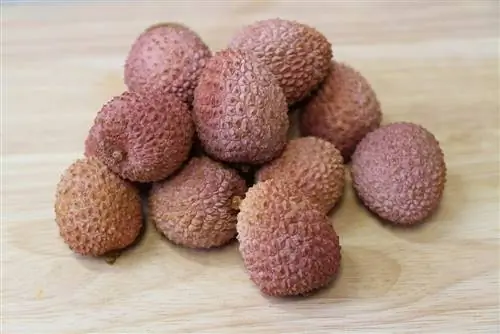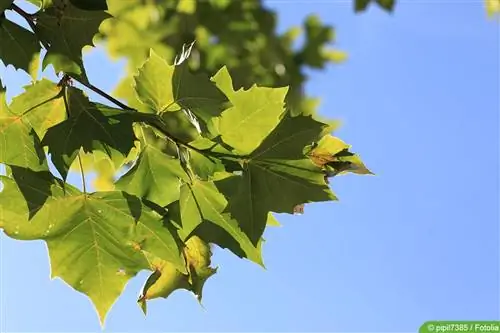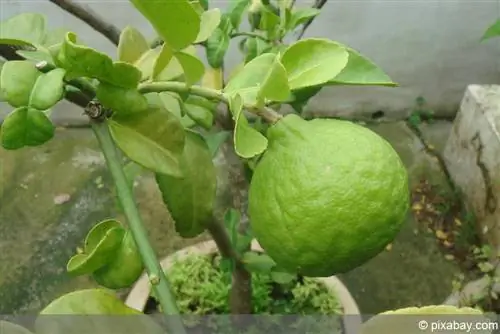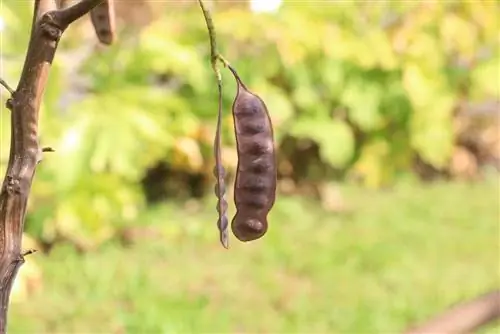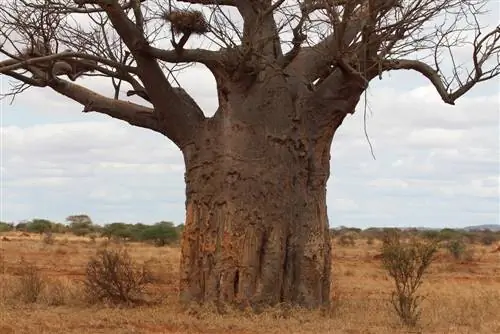- Author admin [email protected].
- Public 2023-12-17 03:39.
- Last modified 2025-01-24 12:45.
Although the lychee tree generally does not bear fruit in these regions, it is a popular houseplant thanks to its magnificent foliage. However, if you want to grow the exotic plant in your living room at home, you need sensitivity and a lot of patience. This is because the evergreen plant only grows extremely slowly, even under optimal conditions. If you're looking for a challenge, growing a lychee tree is definitely a good idea!
Location
The lychee tree is grown worldwide in subtropical climates and thrives best in the living room at home when these climatic conditions are simulated. The lychee tree therefore needs a location with as much sun as possible, ideally under glass. However, caution is advised with seedlings and young plants, as they cannot tolerate the blazing sun. It is therefore advisable to slowly get them used to the midday sun and to provide light shading initially. The same also applies to overwintered lychee trees! In addition to lots of sunlight, the exotic also has the following demands on the location:
- as warm as possible, but not too hot
- Temperature not below 12 degrees
- ideal temperature is around 25 degrees
- high humidity
- Humidity never below 70 percent
Tip:
In summer, the lychee tree can be placed on the balcony or terrace without any concerns. However, it is important that the location is as protected as possible.
Substrate
There are various options available for the substrate: The lychee tree thrives in a simple mixture of sand and clay as well as in clay-containing garden soil, which is improved with coconut fibers and lava granules. As an alternative to lava granules, perlite breathing flakes can also be used. The lychee tree grows best when the substrate has the following properties:
- permeable and loose
- slightly sour
- pH value max. 7
- nutrient poor
- good water storage capacity
Tip:
If you take the components for the substrate from your home garden, you should remove any germs from them before using them. To do this, the ingredients are heated in the oven for about 30 minutes at 150 degrees with top and bottom heat.
Sowing
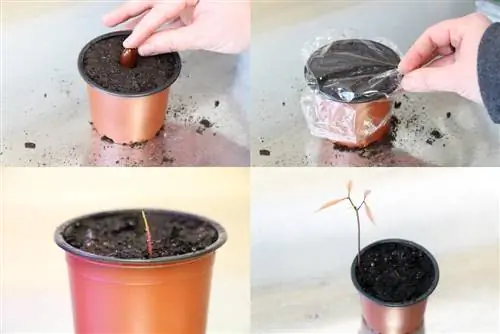
Sowing is relatively uncomplicated and is done using the lychee seeds. These can be obtained quickly and easily from the ripe fruits. You can tell whether a lychee is ripe by its appearance, as its shell is pink to dark red and has no green spots. A ripe fruit can also be peeled without much effort, as its peel gives slightly under slight pressure. In addition to the lychee seeds, the following utensils are also required for sowing:
- growing soil
- special cultivation container is optimal
- one vessel per core
- a normal flower pot is also suitable
- However, drainage must be incorporated into these
- to do this, place a shard of pottery over the water drain
- As an alternative, expanded clay balls can be used
- low-calcium, ideally lime-free water
Sowing instructions
If the necessary equipment and the fruits are available, the core must first be obtained. Here, the lychee kernel is carefully removed from the pulp (which can of course be eaten), making sure that the kernel is not damaged in any way. The kernel should then be prepared for sowing as quickly as possible, as storage could impair its germination. The lychee seed is now soaked in warm water for about 24 hours. It should remain in it at least until its chestnut-brown shell opens and can be removed. You can then start sowing:
- Fill the container with potting soil
- leave a small pouring edge free
- Place seeds about 1 to 2 cm deep in the soil
- Core should be on the side
- cover with substrate and press lightly
- water with spray bottle
- Pull the foil over the vessel
- peel this off daily (prevents mold formation)
- Keep soil evenly moist
- not wet under any circumstances!
The seed tray is then placed in a bright location, although direct sunlight should be avoided as much as possible. It is optimal if the place is as warm as possible, because the ideal germination temperature is around 25 degrees. After around 7 to 30 days, the first leaves usually form and the seedling can be repotted.
Repotting

Once more than three pairs of leaves have formed, it is time to repot the seedling. The new planter should be large enough so that the lychee tree has enough space for the next two to three years. As a rule, a container that is a maximum of a third larger than the growing pot is sufficient. This is particularly due to the extremely slow growth of the lychee tree. In addition, in a container that is too large, he would focus on rooting instead of on the growth of shoots and leaves. That's why the lychee tree is only repotted when the substrate is completely rooted. Repotting is as follows:
- Incorporate drainage layer into the vessel
- ideally cover with breathable fleece
- Fill the container with substrate
- press a small depression in the middle
- Remove the seedling with soil and roots from the seed tray
- leave the core on the plant
- Roots must not be damaged under any circumstances!
- Place the seedling in the middle of the hollow
- Fill the container with substrate
- maintain previous plant depth
- Press the soil gently
- then watering
Note:
The core must under no circumstances be removed when repotting, as it supplies the plants with valuable nutrients in the following weeks and months.
Fertilize
The lychee tree's nutrient requirements are relatively low because it grows extremely slowly. The lychee tree should not be fertilized in the first few months as it receives the necessary nutrients from the core. The lychee tree can be fertilized from the third month of its life, although it should be mentioned that fertilizing does not stimulate growth. It is therefore not possible to “force” the lychee tree to grow by increasing the amount of fertilizer. However, the lychee tree also benefits from careful fertilization every now and then:
- fertilize from the 3rd month of life
- from April to October
- about every 4 to 6 weeks
- organic fertilizer is optimal
- this one contains little s alt
- Liquid fertilizer is also suitable for tropical plants
- or highly diluted liquid fertilizer
- as long as they are as low in s alt as possible
Tip:
To protect the roots, it is advisable to water the lychee tree before and after fertilization.
Pouring
When supplying the lychee tree with water, sensitivity is required because it prefers light ball moisture all year round. Accordingly, the exotic animal wants to be watered regularly, but only with small amounts of water. It is best to let the soil surface dry slightly before watering again. However, the soil must never dry out completely, which is why regular checks are advisable. It is best to water with rainwater, although low-lime water is also suitable for this.
Cutting
The lychee tree grows extremely slowly and even takes breaks in growth of up to two years in between. Therefore, it is fundamentally not necessary to cut this plant. However, diseased and dead shoots should always be removed. It is therefore advisable, especially at the end of the winter, to check the lychee tree for dead or diseased wood. However, if necessary, shoots that are too long can be cut back as follows:
- in March/April
- cut just above a bud
- this should be directed outward if possible
- this promotes better branching
Note:
If the lychee tree loses a shoot every now and then, this is not a cause for concern, but completely natural!
Wintering

The exotic plant is absolutely not tolerant of frost, as temperatures below 10 degrees are problematic for it. In addition, the lychee tree needs a lot of light even in the winter months, which is why artificial lighting using plant lamps is essential. But it's not just the lighting conditions that are problematic, because the humidity is usually not sufficient either. Therefore, it is advisable to place a humidifier in the same room. In order to overwinter the lychee tree successfully, the following requirements must be met:
- bright location
- Temperatures between 12 to 15 degrees
- older plants like it a little cooler
- about 75 percent humidity
- water less
- it's better to spray the plant with water
Tip:
The cooler the plant is, the less it is watered!
Propagate
The lychee tree can be propagated both by seeds (see sowing) and by cuttings. Propagation by cuttings is best done in the warm summer months, as the climatic conditions are best at this time. However, if you want to propagate the exotic plant using cuttings, you need a perennial plant with enough side shoots. A half-woody head shoot that does not flower and is around 15 centimeters long is best suited. Once the optimal cutting has been chosen, there are two different methods for propagation to choose from:
Propagation in pots
For propagation in pots, loose, nutrient-poor soil is required next to the planter. The best solution for this is a commercially available potting soil, which is mixed with sand and clay. Since the cuttings require an enormous amount of light, it is also advisable to have a plant lamp ready. Because these are needed even on cloudy summer days. If the necessary equipment is available, the cutting can be propagated in the pot as follows:
- Insert cuttings
- place in a bright, warm location
- A window sill is ideal
- but avoid direct sun
- optimal temperature 25 degrees
- Keep soil constantly moist
- do not fertilize
Propagation in a glass
In addition to the cutting, all you need is a glass and stale, room temperature water. The cutting is now placed in the glass and then placed in a warm, bright location. Although the cutting needs a lot of sunlight, the blazing sun should definitely be avoided. The cutting can be left more or less to its own devices as long as the water is changed regularly. After the first roots have formed, it can be placed in a pot.
Pests and diseases
If the lychee tree is cultivated in the living room at home, it is relatively rarely affected by diseases or pests. Only spider mites could cause problems for the exotic animal. It is therefore advisable to regularly inspect the evergreen tree for pests, especially in the winter months.
Care errors
It is not uncommon for the leaf tips of the lychee tree to turn brown. However, this unsightly discoloration can usually be traced back to care errors or the wrong location. Because both too little light or water as well as too low air humidity are noticeable through the browning of the leaf tips.

